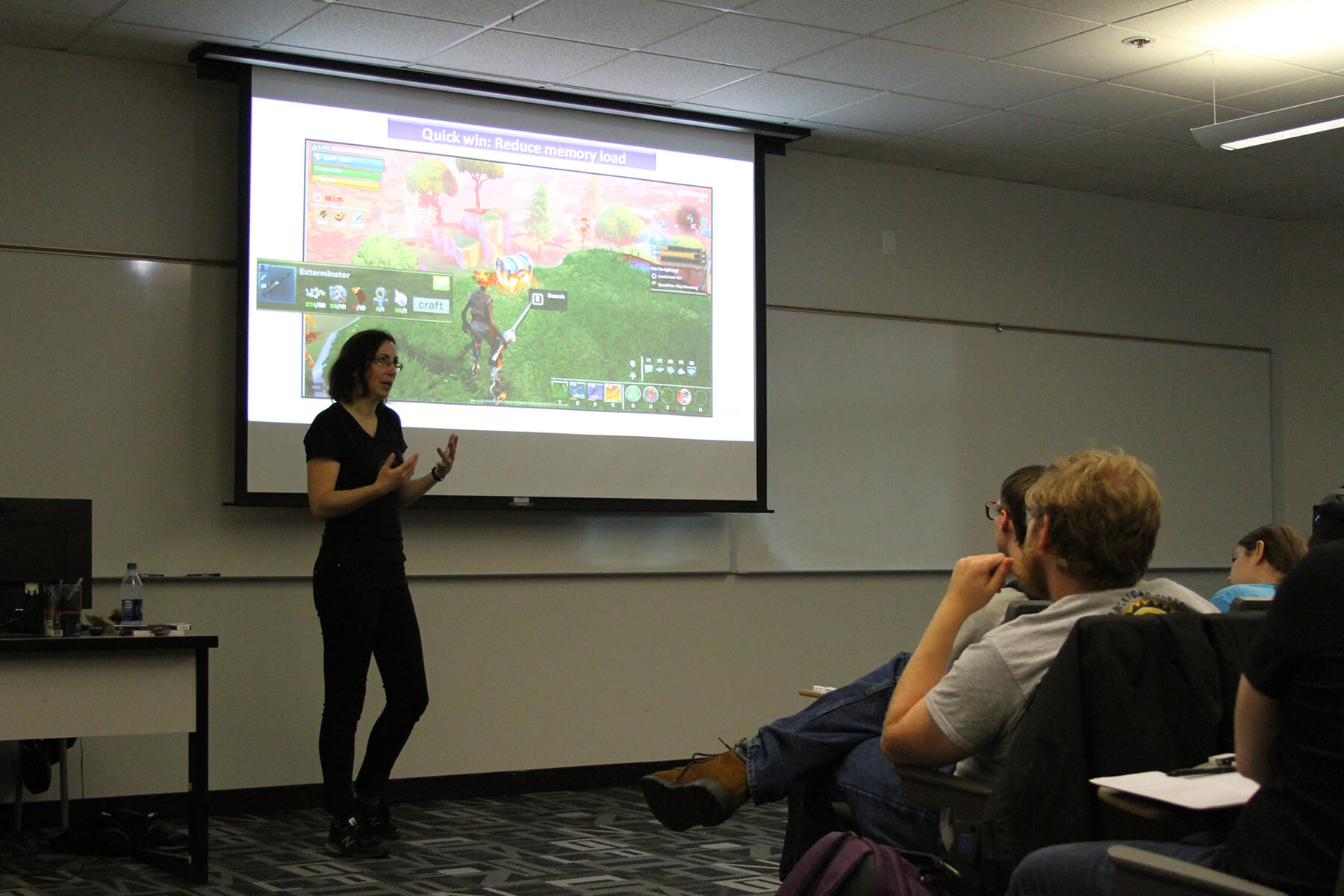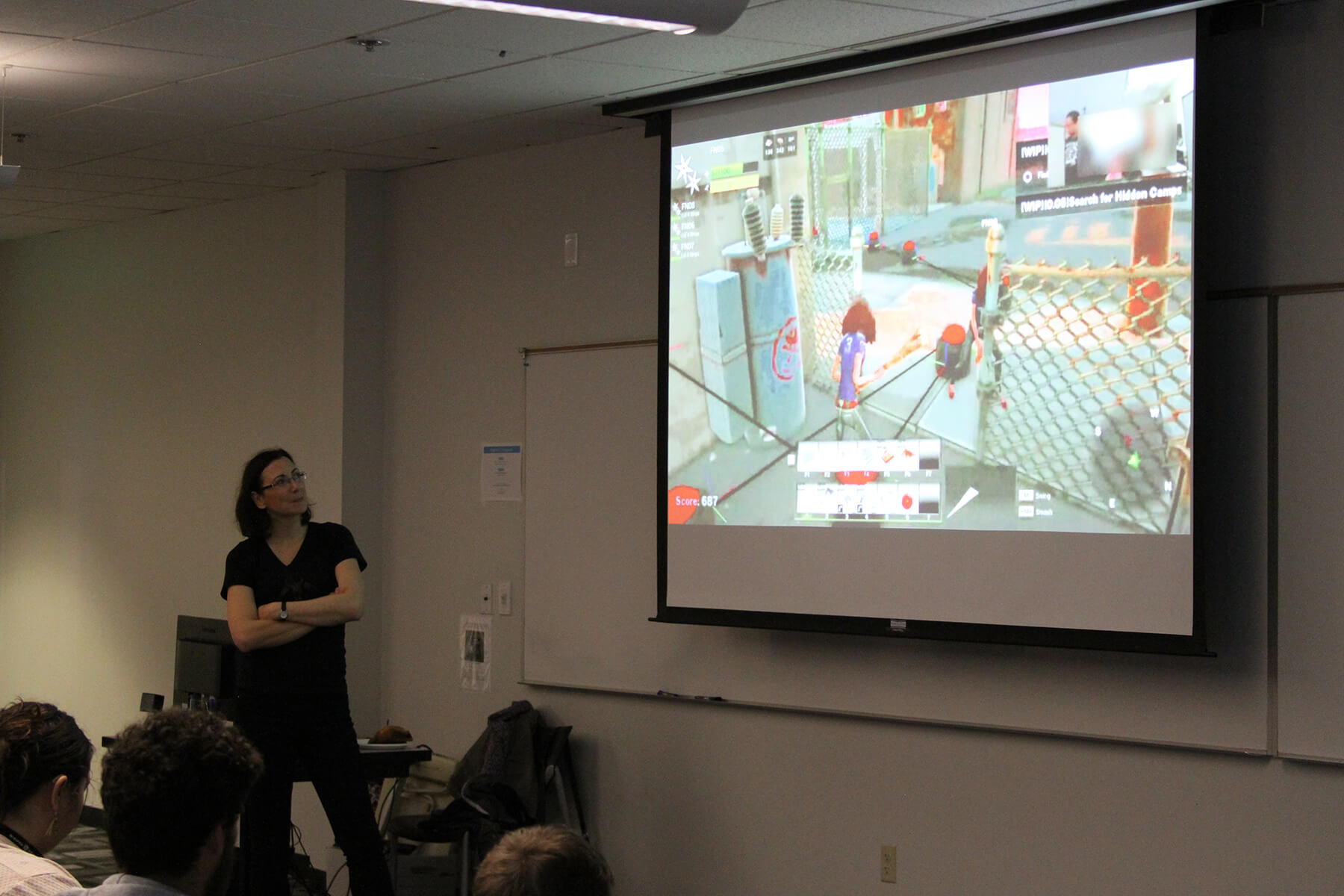At its core, modern triple-A game development is the act of conjuring up new worlds for players to inhabit and engage with. Deep into the development process, however, it can be jarring for a game maker to discover that the world that sprang forth from their brain is being experienced entirely differently in the brain of the player — a rift that can completely derail a game.
The increasingly important field of UX, or “user experience,” is dedicated to eliminating that potential rift – a challenge that can be overcome with careful planning, testing, and a solid grasp of how the brain functions. Dr. Celia Hodent, a cognitive scientist, 13-year game industry veteran, and author of The Gamer’s Brain: How Neuroscience and UX Can Impact Video Game Design, has dedicated her career to understanding the science behind how players interact with video games on a psychological level. She graciously shared some of her expertise with DigiPen students during a special guest presentation and Q&A session on October 1.
“You know your design, so it’s really hard to have objective knowledge of it — because you can’t step back. This is called ‘the curse of knowledge,’” Hodent said. “You have to make sure that what your intention is is what the players are going to be perceiving. So you need to bring people in who are your target audience and see how people actually interact with the game, and then ask, ‘What tradeoffs are we going to make [in order] to make sure this sticks to our intended experience?’”
During her 13-year career, Hodent’s expertise in game psychology and UX has been called on by major studios like Ubisoft and LucasArts, where she worked on blockbuster franchises like Rainbow Six and unreleased Star Wars titles, respectively. During her DigiPen presentation, Hodent outlined UX principles and their effect on the development process, using her recent work with Epic Games on the development of the smash hit Fortnite as an example.
You have to make sure that what your intention is is what the players are going to be perceiving.”
“I’m usually called a bit late,” Hodent said, “but with UX, the earlier the better. With Fortnite, I actually worked very closely with the development team really early, which made a big difference, because we were able to test things early on when they weren’t sure about what decisions to make. In Fortnite, there were sprints that were dedicated solely to working on UX fixes. It’s really important to have that mentality, because if you try to add more features before your foundation is solid, it’s going to crumble, and things are going to get expensive and way harder.”
For Fortnite, a game that combines resource management, fast-paced combat, and a complex building mechanic, insuring that players could clearly perceive what was happening on-screen and fully engage in the gameplay was of paramount concern.

“Your players are going to try to figure out your game with as little information as possible and misinterpret what you’re trying to make them do,” Hodent said. “The player should be challenged in areas where you want them to be challenged, not in trying to figure out what icons mean or what they’re supposed to do next.”
The player should be challenged in areas where you want them to be challenged, not in trying to figure out what icons mean or what they’re supposed to do next.”
Hodent presented a number of videos from Fortnite’s early testing period to illustrate this very point. In one clip, players were tasked with turning on a machine by connecting it to a generator. “We were watching this playtest, and we were like, ‘Oh my god, what is happening?” Hodent said. Not realizing its potential to confuse players, Fortnite artists had placed purely decorative transformers with electric spark animations within the same level. “They bumped into that first, believed that was the generator, and tried for 10 to 15 minutes to connect this thing to the machine, even though there was no feedback indicating that it was working,” Hodent said. “This is the reason you need to try and put yourself in the shoes of the player, who doesn’t know what the difference is between a gameplay objective and a decorative asset. Players want to figure things out by themselves.”
Sometimes, making sure players perceive the right thing is as important as making sure developers are perceiving the correct problem to fix. “Solving a problem is easy, but solving the right problem is harder,” Hodent said. As an example, players reported that Fortnite started feeling too “grindy,” when it came to gathering resources. “You could say, ‘Oh, it’s my systems design. Maybe the numbers aren’t right,” Hodent said. “But you might not need to solve something in the design. You might just need to fix something with the player perception. Maybe there are things that are making it feel like it takes you longer to gather resources than it does in reality.”

Indeed, Hodent discovered that players’ reports of “grindiness” wasn’t necessarily the fault of the numbers in the systems design. It could be assumed that the feeling was tied to the fact that the pop-up 3D model indicating a gathered resource’s type is much larger and more central than the one indicating the amount gathered, making it seem like they’d gathered one piece of material when in reality they’d gathered far more.
For other players, the grinding feeling could be the result of them missing one of the resource gathering system’s core mechanics entirely. “Every time you harvest something, you can get it faster if you hit it at its weak point,” Hodent said. “The harvesting system design is based off of that. We anticipate people will use that, so the numbers are based around that. If they don’t use it, of course it would feel grindy.” As it turned out, many players either mistook the on-screen weak-point indicator for a general targeting indicator or missed the indicator entirely. After toying with the color and placement of the indicator, designers realized players would use and understand the feature more if it was reworked as an early unlockable skill in their skill tree, rather than a given feature from the get go.
“After we did that, now it becomes a reward that has meaning, and more people were paying attention to it,” Hodent said. “So now 80 to 90 percent of people finally used the weak points in our playtests. We spent a lot of time on something that seems really small, but it potentially has really big impact on long-term engagement and that feeling of grindiness. Sometimes you need to work on something really small because it impacts that larger gameplay. This is why UX should be the concern of everyone. UX is about the whole experience you want to offer to your players.”
